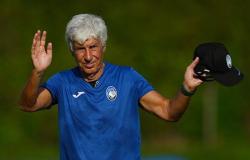The Holy Shroud, its symbolic value and the panorama of the extensive scientific studies that examine it in depth were at the center of the meeting “The Holy Shroud,…
Already a subscriber? Log in here!
SPECIAL OFFER
FLASH OFFER
ANNUAL
€49.99
€19
For 1 year
CHOOSE NOW
MONTHLY
€4.99
€1 PER MONTH
For 3 months
CHOOSE NOW
SPECIAL OFFER
SPECIAL OFFER
MONTHLY
€4.99
€1 PER MONTH
For 3 months
CHOOSE NOW
Then only €49.99 instead of €79.99/year
Subscribe with Google
The Holy Shroud, its symbolic value and the panorama of the extensive scientific studies that examine it in depth were at the center of the meeting “The Holy Shroud, yesterday, today and tomorrow” organized yesterday morning, at the library of the Episcopal Seminary of Caserta , by the Caserta delegation of the Equestrian Order of the Holy Sepulcher of Jerusalem with the patronage of the Diocese of Caserta, the City of Caserta, the Historical Society of Terra di Lavoro and the “Customs of Ancient Campania” association.
«When we talk about the Shroud – explains Gian Maria Zaccone, speaker of the event and director of the International Center for Studies on the Shroud – many immediately focus on its study and historical analysis, aiming primarily to demonstrate that the linen cloth preserved in Turin is objectively belonged to the funerary objects of Christ. I find it frustrating, also because I believe that it is particularly difficult to document its originality exclusively through the historical path, which is also largely incomplete. The research carried out by the Center is of a strictly scientific nature, it investigates the origin of the object but also the object itself and for this reason it attracts collaborators of proven ability and absolute objectivity from all over the world, of different religions and even with different opinions on the originality of the Shroud. I assure you that, from a scientific point of view, there are more things about the Shroud that we ignore than those we know.”
The speech – preceded by greetings from Andrea Sibilio, Caserta delegate of the Order, and from Marinella Tucci, principal of the Terra di Lavoro Maria Santissima Section, Enzo Battarra, Councilor for Culture of the City of Caserta, and moderated by Alberto Zaza d’ Aulisio, president of the Historical Society home of Terra di Lavoro – aimed to dispel some myths about the Shroud and above all to underline its iconographic value: «Both Pope John Paul II and Pope Benedict XVI – continues director Zaccone – underlined the value of its image recalling a profound meaning for what is represented and not for the representation itself. For us the Shroud is this, an image, perhaps even a relic but above all an image and we study it for this, to appreciate it fully.” Speeches and greetings were also given by the delegates of the Order of Aversa, Capua and Alife-Sessa-Teano – Raffaele Piccolo, Marilena Scudieri and Gian Marco Imbroglia respectively – and by the lieutenancy councilor Carlo Pubblico.
With a presence of just under one hundred knights in Terra di Lavoro – whose founding nucleus was established in 1983 at the behest of Bishop Vito Roberti – the Order of the Holy Sepulcher is responsible for supporting the Latin mission in the Holy Land – promoting the training of young people and solidarity initiatives – and also carries out activities of closeness to the least fortunate in the local area. Together with cultural initiatives, such as the conference just held, the Order promotes and supports the “La Famiglia in Cammino” listening center at the cathedral of Caserta which offers assistance to those asking for help with an appointment every Friday at 6.00 pm. Oblations aimed at supporting the Holy Land remain the main activity carried out also through promotional initiatives capable of drawing attention to the theme of solidarity.
«The Knights are called to the mission and the Holy Shroud does nothing but remind us of this – recalled Bishop Pietro Lagnese during the homily of the celebration that followed the meeting – recalling the figure Joseph of Arimathea and his profound sense of piety in asking Pilate for the body of Christ and placing it in the tomb.”
© ALL RIGHTS RESERVED
Read the full article at
The morning






